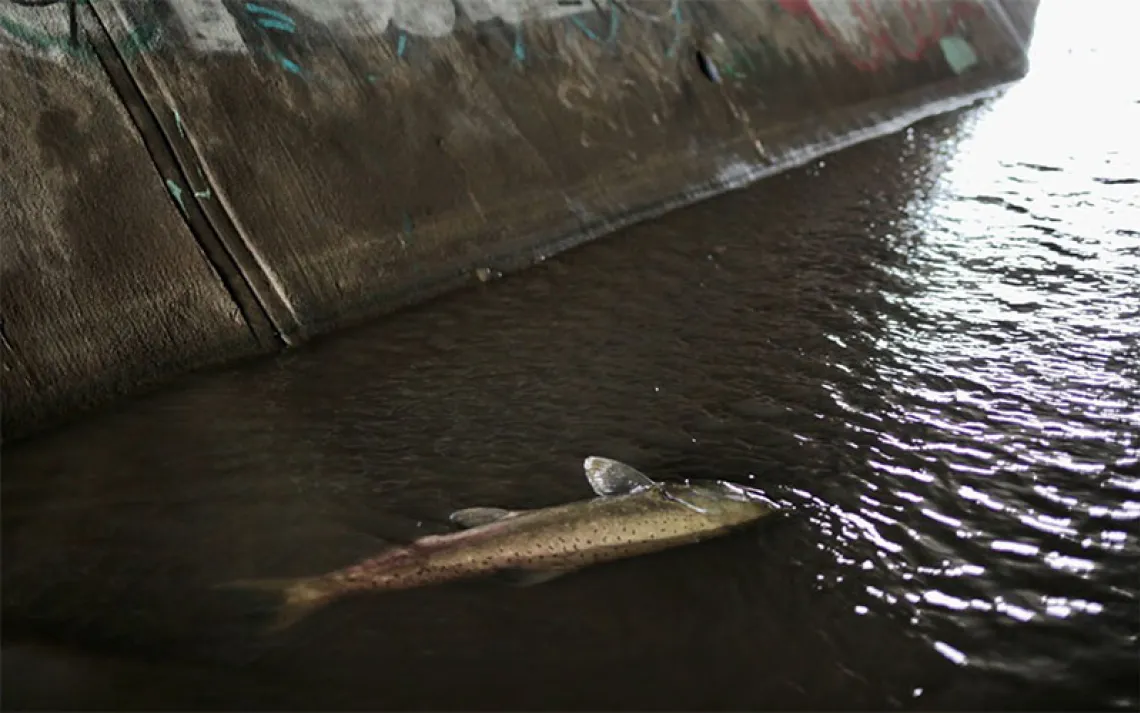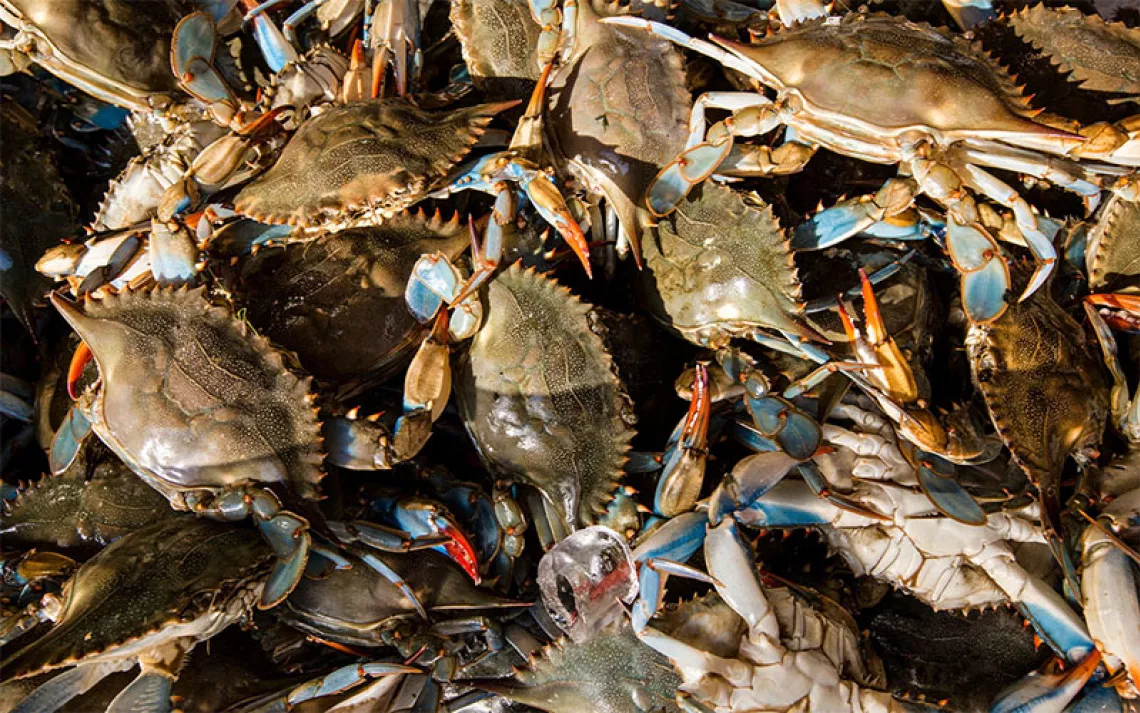At Rattlesnake Roundups, Cruelty Draws Crowds
An annual killing extravaganza in Sweetwater, Texas, draws increased scrutiny

More than 250,000 rattlesnakes have been caught and killed in the Sweetwater Rattlesnake Roundup. | Photo courtesy of Jo-Anne McArthur/We Animals
At the Nolan County Coliseum in Sweetwater, Texas, thousands of western diamondback snakes have spent the last couple of weeks without food, water, or light. Many were brought there after hunters flushed them out of their dens with gasoline, a uniquely Texan snake-hunting technique aptly called “gassing.” This weekend, they will all be killed as part of the main event in the world’s largest rattlesnake roundup.
These “festivities” have been taking place in the small West Texas town for 60 years. After being dropped off at the county fairgrounds, the snakes are weighed, measured, and milked for venom before they are tossed into pits—a stressful experience for the solitary animals, which respond by biting and defecating on each other as snake handlers stir the teeming masses to prevent suffocation. Mobs of onlookers from around the world await the ritual reptile decapitation, some with cellphones raised to capture the moment and snap a selfie with a bloodied stump. The still-writhing bodies are skinned for accessories, flayed for meat (Southern fried snake is available at the concession stand with fries and a soft drink), and the organs collected to sell overseas. For a small fee, children can try their hand at stripping snake skins and add their bloody handprints to the event’s mural. High school beauty queens join in with perfectly coiffed curls and smiles to compete for the coveted title of Miss Snake Charmer.
The Sweetwater Rattlesnake Roundup started this Thursday and will continue through the weekend. A $60 weekend pass will give the expected 40,000 visitors access to the bloody spectacle—plus carnival rides.
The pageant of cruelty has been taking place for decades, but now it’s beginning to generate increasing opposition from some animal rights groups and scientists who say it’s unnecessary and willfully brutal.
“It was a really difficult thing to witness,” says Melissa Amarello, cofounder of Advocates for Snake Preservation, who attended the festival in 2015 to document its proceedings. “Snakes feel pain. They have emotions. They have relationships with other snakes.” Amarello recalled a distinct musk in the air, which she recognized as the fear pheromone released by snakes in the wild, and a cacophony of rattling, the closest snakes come to screaming.
Opposition to the Sweetwater Rattlesnake Roundup has gained momentum in recent years. Since protestors at the event are often brushed off in the festival frenzy, groups like the Texas Snake Initiative have started social media campaigns to spread the word about the roundup.
“A lot of Texans that we talk to don’t realize the roundup exists in the first place,” says Haley Pittman, director of the Texas Snake Initiative. “I think it’s eye-opening for a lot of people.”
In 2013, the Texas Snake Initiative partnered with the Center for Biological Diversity to lodge a petition with the Texas Parks and Wildlife Department to ban the practice of gassing. The groups warned that gassing can impact non-target wildlife such as threatened species like burrowing owls and noted that 29 other states have banned the process.
In response, the department proposed a new rule limiting the use of petrochemicals for hunting, but it was tabled in favor of a Snake Harvest Working Group. A third of the group were from Sweetwater, and according to John Davis, wildlife diversity program director at the Parks and Wildlife Department, the voting for the various points of consideration reflected the vested interests of the Sweetwater residents. For example, the working group was presented with studies from 21 snake-themed events that showed no direct correlation between snake numbers and event attendance or revenue. Four of the 12 members still insisted that Sweetwater is an exception to these reports because its reputation as the largest rattlesnake roundup drives attendance and economic impact. “I’ll give you one guess who those four members were,” Davis says. Proposals for limiting gassing geographically and enacting a statewide ban were met with identical levels of disagreement. As a result, no further action has been taken to reform gassing rules.
Sweetwater’s Rattlesnake Roundup may seem like it came from the era of the Wild West, but in fact it’s a wholly modern phenomenon. The event started in 1958, when the Sweetwater Jaycees started the roundup to ease ranchers’ fears about rattlesnakes endangering livestock, workers, and their families. Since then, the roundup has become a major economic engine for the community. According to a 2015 economic impact analysis conducted for the town by an outside consultant, the Rattlesnake Roundup generates $8.4 million in economic activity in Sweetwater every year. That’s a big number for a town of 11,000 where about 25 percent of people live below the poverty line. While there are other economic drivers in the area—including manufacturing, railroads, and four of the 11 largest wind farms in the world—the Rattlesnake Roundup holds a special place in the town’s identity.
The rationale for the event is rooted in the idea of controlling snake populations, yet roundup proponents contradictorily claim that the event does not have an impact on snake populations. There is a lack of definitive data to support this because rattlesnakes are not protected by the same regulations as other hunted animals. The professional rattlesnake hunters are not bound by take limits as other game hunters are. Hunters for the Sweetwater Rattlesnake Roundup are paid by weight and are awarded cash prizes for bringing in the most and biggest snakes. In 2016, the festival took in a record haul of 24,262 pounds of rattlesnakes; in 2017, organizers capped that number at 6,500 pounds.
There is a prevailing sentiment in West Texas that the only good snake is a dead snake. The fear is real—studies suggest that humans’ coevolution with venomous snakes has primed our neural networks to fear them more readily—but herpetologists say it’s misguided. The CDC estimates that between 7,000 and 8,000 people are bitten by venomous snakes in the United States every year. This figure includes copperheads, cottonmouths, and coral snakes as well as rattlesnakes—and about five of those people die. The U.S. Department of Agriculture has logged zero cattle deaths from snakes in more than two decades; livestock usually recover from bites without treatment.
“Rattlesnake bites are painful and unpleasant, but the risk in developed countries is really exaggerated,” says Harry Greene, a herpetologist and professor of evolutionary biology at Cornell University.
Adrian Berg, a board member at Texas Reptile Conservation Outreach, says youth education is the key to improving the public perception of snakes. The organization runs “Texas Venom Experiences” throughout Texas and Louisiana, which teaches attendees how to coexist with venomous snakes. “If we can teach them how valuable these animals are, they learn appreciation not just for snakes but also for their environment as a whole,” Berg says.
Other rattlesnake roundups have moved to eschew cruelty in favor of education. In 2012, Claxton, Georgia, ended its 40-year tradition of killing roundups and replaced it with a Rattlesnake and Wildlife Festival, which will also take place this weekend. The efforts to transform the roundup into a wildlife appreciation festival were spearheaded by One More Generation, an organization started by two local kids.
Heather Dykes, event coordinator at the Evans County Wildlife Club, which hosts the festival, has observed increased attendance to these events. But Dykes notes a key difference: The Claxton event is free and thus does not bring the same kind of revenue streams as Sweetwater’s.
Sweetwater’s Rattlesnake Roundup features some educational programming, but it’s rather sensationalized. In one popular event, a rattlesnake is coaxed into striking and popping a balloon, as facts about snake safety and science are peppered with mythology about the festival’s origins. Ultimately, fear still rules in Sweetwater: fear of venomous snakes, of family and community traditions dying out, of change taking away an economic driver for this tiny Texas town. Will that change in the immediate future? Reckon not, but perhaps the tides are slowly changing.
 The Magazine of The Sierra Club
The Magazine of The Sierra Club



